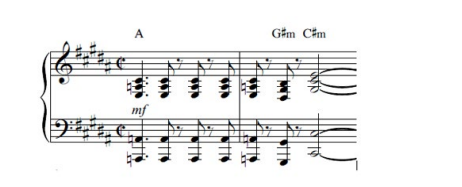Africa chord progressions and keys 🌍
1/35
Earn XP
Description and Tags
Information taken from eduqas' final analysis
Name | Mastery | Learn | Test | Matching | Spaced |
|---|
No study sessions yet.
36 Terms
What are the chords present in the introduction?
A, G#m and C#m
Where can the three chords in the introduction be heard?
They can be heard in Riff A

Is Riff B heard above a sustained chord? If so, which chord is it?
It is heard above the sustained chord of C#m
What scale is Riff B based on?
E major pentatonic scale
What section(s) does Riff A NOT appear in?
Chorus 1, 2, 3, (and 4)
In which section is Riff B developed?
The instrumental solo
What features of Motifs X and Y connect them to traditional African music?
Syncopation
Pentatonic scale
Irregular ostinato groupings
How long are the majority of the phrases in Verse 1?
9 bars long
Is the harmonic rhythm fast or slow throughout the majority of verse 1?
Slow
What is the chord progression in verse 1?
B
D#m
G#m
B/F#
A/E
E/F#
G#m
Riff A

What change in the vocals occurs in the final eight-bar phrase of verse 1?
The singer sings an octave higher than previously stated and sings in parallel motion with a background singer who is at an interval of a 3rd below
What is the chord progression of the final phrase of verse 1?
B
D#m
G#m
G#m
Riff A
C#m
C#m

In the choruses, how do the vocals change throughout the phrases?
The first phrase is sung as a solo
The second phrase is sung as a duet
The third and fourth phrases are sung as a trio
Is the range in the choruses wide or narrow?
Narrow range, in the first three phrases of the chorus it is only a semitone
What is the chord progression in the choruses?
F#m
D
A
E

What is the chord structure often used in pop music that is present in the choruses?
vi
IV
I
V
What does the vocal melody end with on the final phrase of the chorus?
It ends with a melisma from the singer, which contrasts the syllabic rest of the chorus and the majority of the piece
In what way is the final six-bar phrase different in terms of chords from the other phrases in the chorus?
The first three chords remain the same, however in the final three bars the chords become:
-C#m
-E
-F#m , E/G#
in preparation for the key to modulate back to B major

What difference is there between the link and the introduction?
The original four-bar section is repeated only once instead of the three times in the introduction
What structural difference is present between verse 1 and verse 2?
Verse 1 has four phrases, whilst verse 2 only has three
What instrumental difference is there between verse 1 and verse 2?
Verse 2 has a recorder playing a descending scale beneath the vocals. This is called a countermelody or descant.
What slight change occurs in the pitch of the vocal melody across verse 1 and verse 2?
In the final phrase, the singer leaps up to a D# and C# on the words ‘deep in’
What change occurs in the backing vocals in verse 2 compared to verse 1?
On the fifth bar of the nine-bar phrases, the backing vocals enter singing ‘ooo’ before joining the lead singer on the final word of each phrase
What are the differences between chorus 1 and chorus 2?
There are no differences between them
What are the differences between link 1 and link 2?
There are no differences between them
What other part of the piece is the instrumental solo structured off of?
It is structured off of Riff B and the accompaniment of the verse
How do the structures of verse 1, verse 2 and the instrumental solo compare to each other?
Verse 1 has three nine-bar phrases before the eight-bar transition to the chorus
Verse 2 has two nine-bar phrases before the eight-bar transition to the chorus
The instrumental solo has only one nine-bar phrase before the eight-bar transition to the chorus
Describe the first four bars of the instrumental solo in terms of rhythm and tonality.
It is a descending melody using a B major pentatonic scale with the notes falling into groups of three and ending with a triplet

Describe the fifth to ninth bars of the instrumental solo in terms of rhythm and tonality.
An ascending and descending melody using the E major scale which contains more rhythmic variety than the first

Describe the final three bars of the instrumental solo in terms of rhythm and tonality.
An ascending melody, also using the B major pentatonic scale with the notes once again falling into groups of three. This time the phrase ends in a more ‘pop’ style with the use of grace notes and syncopation

What differences are there between chorus 3 and the previous two choruses?
A new electric guitar riff is heard after the singer sings
‘I bless the rains down in Africa’ is repeated five times, making this chorus significantly longer
During phrase 3, there is solo vocal improvisation at the end of the first, second and fourth repeats. Each of these improvisations are different.

How does the outro compare to the intro?
The outro repeats the music stated in the introduction, but gradually reduces the texture until only the bass line of Riff A and the rhythm track from the beginning of the track are heard.
What are the dynamics of the piece?
Generally mezzoforte, however the choruses are forte
What is the tempo of the piece?
Moderately fast
What is the general instrumentation of the piece?
Drum kit with additional percussion
Lead guitar
Bass guitar
Synthesisers
Male lead vocals
Male backing vocals